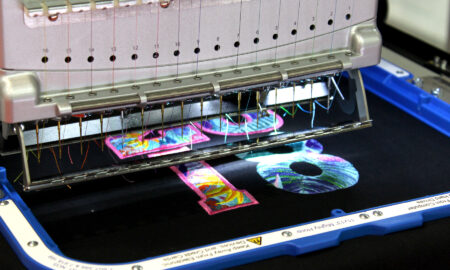Thread breaks can cost you thousands in lost production
Many embroiderers put up with thread breaks when most of them could be avoided. If you have a multi-head machine, the down time can be very costly. For example, if you have a six-head machine, all heads will stop for a thread break until the needle is rethreaded.
Just add up the time that the machine has stopped and multiply that by the times in a day. This will give you the downtime or lost production in eight hours. Customers with Melco EMT16X modular multi-head systems will still lose time but not nearly as much as with a fixed head machine.
If your machines are set up correctly you should only have a few threads break a day.
What causes thread breaks?
They are an irritating part of embroidery, but do not have to be tolerated. By following a few steps when rethreading the needle, you can begin to diagnose the cause of the thread break and hopefully avoid a subsequent one.
Thread breaks can be caused by a multitude of factors, such as:
- Machine (user) – Is the machine threaded correctly? Is the needle oriented correctly? Has the machine been serviced?
- Embroidery design – Is the design good, this could be the source of thread breaks?
- Materials used – Are you using good thread and backing?
- Machine (mechanical) – Most people tend to blame the machine for the problem but very often it is another issue. However, there are a few things you could address before calling out a technician. These are detailed below.
Troubleshooting the upper thread path
The upper thread path should allow the thread to run smoothly from the cone to the eye of the needle. If there are rough spots or it does not follow correct path, then breaks will occur.
Needle not correctly positioned
Embroidery needles have a front and back side. If you install in backwards, you will most likely encounter thread breaks within the first few stitches. The front of the needle has a groove (thread guide) while the back has a indented notch (scarf) just above the eye of the needle.
Ideally the eye of the needle should be 5⁰ to the right of the centre when sewing. There is some small tolerance on this, but 5⁰ is ideal. The chance of thread breaks will increase if the angle is too great.
Troubleshooting the bobbin case and thread
Thread breaks can occur from issues with the bobbin or case. Please check the following:
- Wrong type of bobbin.
- Bobbin thread is low or run out.
- Bobbin is overwound.
- Bobbin case not properly inserted.
- Bobbin tail to short after trimming.
- Improper bobbin tension.
- Dirty or damaged bobbin case.
Presser foot too high
If your presser foot is adjustable, check that it is the correct height from the material.
If it is too high, this will result in thread breaks.
Upper thread tension incorrect
Correct thread tension is essential for both good quality embroidery and high production.
Incorrect thread tension can cause looping, white bobbin thread showing on the top and a cause of thread breaks. The correct tension for satin stitches should reveal 1/3bobbin and 2/3 top thread colour on the underside of the embroidery. The Melco EMT16X has automatic thread tensioning which gives a consistent thread tension on all materials, regardless of the garment or material.
Sewing hook
If you find that you are having thread breaks on all needles of a head, it is more likely to be the sewing hook that is at fault.
It could be that the timing is out or there is damage to the hook. If you have not had experience of re-timing a hook before then it would be wise to have a qualified technician take a look.
Other factors that you should consider are the quality of the design, thread and backing.
If it is the first time you have run the design, it could be that there are too many small stitches in certain areas. Make sure you are using a good thread; poor thread will give you thread breaks.
The same goes with backing. If the backing is poor or the wrong type you will have thread breaks and poor-quality embroidery. Remember, saving a little on supplies could cost you thousands in lost production.
At the end of the day, look after your equipment and it will reward you with more production and less stress.
































